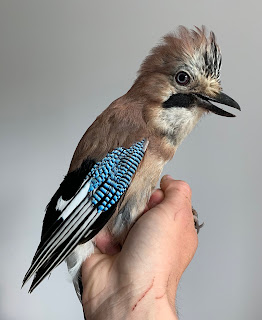It’s been a reasonably quiet spring/summer for UEARG so
there isn’t much to update on. Nest boxes on campus were checked earlier in the
season and produced plenty of broods of Blue and Great Tits, a reasonable year
productivity wise it seemed. Other than that, members of the group have joined
other local ringers or groups assisting with their CES (constant effort site)
activities, and other bits and pieces such as swifts, raptor pulli, and spotted
flycatcher pulli. We’ve also had group members going further afield with their
ringing, visiting Bird Observatories such as Fair Isle and Calf of Man, and
even as far as Iceland. Things should hopefully start to pick up now though as
the summer progresses and Autumn comes ever closer. This morning six of us
gathered for a big net-ride clearing and preparation session at one of our best
sites in the Yare Valley, and should allow us to get back on site to monitor how
the birds are doing.
For this blog I thought I’d briefly touch upon a surprising addition
to group ringing totals this year, mine and Kirsty’s garden. If you’re a ringer
or have spoken to a ringer about how many different individual birds are coming
to your feeder, I’m sure you know it’s way more individuals than you would think.
Even so, we’ve been pleasantly surprised by just how many are using our
relatively modest sized garden (10x20m ish). We are lucky enough to have a garden
that backs onto a small woodland, so I’ll preface the numbers with that, but we’ve
had 358 different individuals across 18 species. Those totals cover just 4 months
of ringing in our garden since we moved in, and with new individuals caught
each session it’s set to rise further. Typical catches are dominated by a
handful of species (e.g. Blue Tit, Great Tit, Dunnock, Robin), and we have been inundated with juveniles. Perhaps another sign that the tits have had a productive breeding season. The biggest surprise for us however, has been the number of
different Jays that visit the garden. Today we caught number 12! Other highlights have included confirmed breeding of
species such as Bullfinch, Chiffchaff, and Greenfinch in the area. The woodland is relatively young growth and has has had extensive management in the past, so natural nest cavities are in short supply. This may help explain the lack of some typical woodland species such as nuthatches or treecreepers.
Table 1. Garden ringing totals 31/3/2019-31/7/2019. Brackets show number of juveniles, which have dominated our catch.
|
Row Labels
|
New
|
Retrap
|
Total
|
|
Blackbird
|
19(8)
|
8(1)
|
27
|
|
Blackcap
|
2
|
0
|
2
|
|
Blue Tit
|
104(85)
|
23(21)
|
127
|
|
Bullfinch
|
3(1)
|
0
|
3
|
|
Chaffinch
|
23(19)
|
1(1)
|
24
|
|
Chiffchaff
|
6(4)
|
1(0)
|
7
|
|
Collared Dove
|
2(1)
|
0
|
2
|
|
Dunnock
|
25(18)
|
11(4)
|
36
|
|
Goldfinch
|
8(2)
|
0
|
8
|
|
Great Tit
|
107(67)
|
85(71)
|
192
|
|
Greenfinch
|
8(2)
|
0
|
8
|
|
Jay
|
12(3)
|
3
|
15
|
|
Long-tailed Tit
|
1
|
0
|
1
|
|
Magpie
|
2(1)
|
0
|
2
|
|
Robin
|
23(18)
|
27(7)
|
50
|
|
Starling
|
1
|
0
|
1
|
|
Woodpigeon
|
9(3)
|
5(3)
|
14
|
|
Wren
|
4(3)
|
0
|
4
|
|
Grand Total
|
358
|
164
|
522
|
The juvenile Jays have only just started visiting the garden in the last week. Their underparts are still downy and and the bright blue wing covets show less black barring.
Great tits seem to very readily enter the potter traps here, whilst we seem to catch far fewer blue tits in them.
A fresh juvenile Bullfinch, probably left the nest the day we caught it.
Comparatively more black barring in the wing covets of this adult Jay, and lacks the downy underparts of the juvenile (above).
A staple of garden ringing, a fresh juvenile Blue Tit.
One of our potter trap setups, placed on a bird table I built. The tits seldom enter the traps if they are placed on the ground.
The garden in question (and Sparrow, the dog).








No comments:
Post a Comment